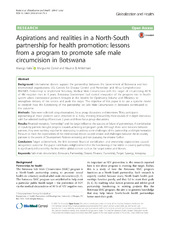| dc.contributor.author | Katisi, Masego | |
| dc.contributor.author | Daniel, Marguerite | |
| dc.contributor.author | Mittelmark, Maurice B. | |
| dc.date.accessioned | 2016-08-10T08:19:38Z | |
| dc.date.available | 2016-08-10T08:19:38Z | |
| dc.date.issued | 2016-07-28 | |
| dc.Published | Globalization and Health 2016, 12(1):42 | eng |
| dc.identifier.issn | 1744-8603 | |
| dc.identifier.uri | https://hdl.handle.net/1956/12533 | |
| dc.description.abstract | Background: International donors support the partnership between the Government of Botswana and two international organisations: U.S. Centers for Disease Control and Prevention and Africa Comprehensive HIV/AIDS Partnership to implement Voluntary Medical Male Circumcision with the target of circumcising 80 % of HIV negative men in 5 years. Botswana Government had started integration of the program into its health system when international partners brought in the Models for Optimizing Volume and Efficiency to strengthen delivery of the service and push the target. The objective of this paper is to use a systems model to establish how the functioning of the partnership on Safe Male Circumcision in Botswana contributed to the outcome. Methods: Data were collected using observations, focus group discussions and interviews. Thirty participants representing all three partners were observed in a 3-day meeting; followed by three rounds of in-depth interviews with five selected leading officers over 2 years and three focus group discussions. Results: Financial resources, “ownership” and the target influence the success or failure of partnerships. A combination of inputs by partners brought progress towards achieving set program goals. Although there were tensions between partners, they were working together in strategising to address some challenges of the partnership and implementation. Pressure to meet the expectations of the international donors caused tension and challenges between the in-country partners to the extent of Development Partners retreating and not pursuing the mission further. Conclusion: Target achievement, the link between financial contribution and ownership expectations caused antagonistic outcome. The paper contributes enlightenment that the functioning of the visible in-country partnership is significantly influenced by the less visible global context such as the target setters and donors. | en_US |
| dc.language | en | |
| dc.language.iso | eng | eng |
| dc.publisher | BioMed Central | eng |
| dc.relation.ispartof | <a href="http://hdl.handle.net/1956/15514" target="blank">The power of context in health partnerships:Exploring synergy and antagony between external and internal ideologies in mplementing Safe Male Circumcision (SMC) for HIV prevention in Botswana</a> | |
| dc.rights | Attribution CC BY | eng |
| dc.rights.uri | http://creativecommons.org/licenses/by/4.0 | eng |
| dc.subject | Safe male circumcision | eng |
| dc.subject | Botswana | eng |
| dc.subject | Partnership | eng |
| dc.subject | Donors | eng |
| dc.subject | Finance | eng |
| dc.subject | Ownership | eng |
| dc.subject | Target | eng |
| dc.subject | Synergy | eng |
| dc.subject | Antagony | eng |
| dc.title | Aspirations and realities in a North-South partnership for health promotion: lessons from a program to promote safe male circumcision in Botswana | eng |
| dc.type | Peer reviewed | |
| dc.type | Journal article | |
| dc.date.updated | 2016-07-28T06:05:07Z | |
| dc.description.version | publishedVersion | |
| dc.rights.holder | Copyright 2016 The Authors | eng |
| dc.identifier.doi | https://doi.org/10.1186/s12992-016-0179-3 | |

